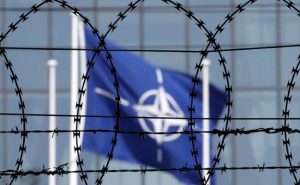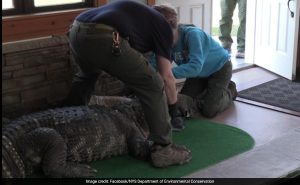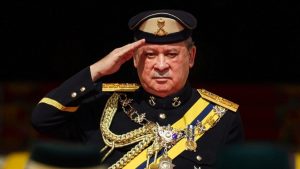As polar ice melts, Russia, already a major Arctic power, wants to make the region its own. China has ambitions for a “Polar Silk Road.” And NATO is embracing Finland — and Sweden too, Washington hopes — giving the alliance new reach in the Far North.
Climate change is accelerating and amplifying competition in the Arctic as never before, opening the region to greater commercial and strategic jostling just at a moment when Russia, China and the West are all seeking to expand their military presence there.
The rising importance of the region is underscored by the travels of Antony J. Blinken, the U.S. secretary of state, who will attend an informal meeting of NATO foreign ministers in Norway on Thursday.
Mr. Blinken is making a point of visiting Sweden and Finland as well, meeting the leaders of all three countries as they press Turkey to ratify Sweden’s quick entry into NATO. He is scheduled to deliver a major speech on Russia, Ukraine and NATO on Friday in Helsinki, the capital of NATO’s newest member.
For a long time, countries were reluctant to discuss the Arctic as a possible military zone. But that is quickly changing.
Russian aggression plus climate change make “a perfect storm,” said Matti Pesu, an analyst at the Finnish Institute of International Affairs. There is a new Cold War atmosphere, mixed with melting ice, which affects military planning and opens up new economic possibilities and access to natural resources.
“So all these are connected and are magnifying each other,” Mr. Pesu said. “It makes the region intriguing.”
While NATO has been cheered by Russia’s difficulties in Ukraine, the alliance in fact has significant vulnerabilities in the north.
Russia remains a vast Arctic power, with naval bases and nuclear missiles stationed in the Far North but also along Russia’s western edge: in the Kola Peninsula, near Norway, where Russia keeps most of its nuclear-armed submarines, and in Kaliningrad, bordered by Poland and Lithuania.
With climate change, shipping routes are becoming less icebound and easier to navigate, making the Arctic more accessible and attractive for competitive commercial exploitation, as well as military adventurism.
Russia has said it wants to make the Arctic its own — a fifth military district, on a par with its other four — said Robert Dalsjo, research director at the Swedish Defense Research Agency.
China has also been busy trying to establish itself in the region and use new unfrozen routes, one reason NATO considers China a significant security challenge.
In its most recent strategy paper, adopted last summer in Madrid, NATO declared Russia to be “the most significant and direct threat to allies’ security and to peace and stability,” but for the first time addressed China, saying that its “stated ambitions and coercive policies challenge our interests, security and values.”
How to create a “northern bubble” to deter Russia and monitor China is one of NATO’s newest and biggest challenges.
In response to NATO’s enlargement, “Russia is putting increasing emphasis on the Arctic, where they’re stronger and less surrounded by NATO,” said Mr. Pesu of the Finnish Institute. Russia may have drawn down its troops to fight in Ukraine, but retains its air power, northern fleet, nuclear submarines and nuclear-armed missiles in the northern realms.
“So it remains a pretty urgent concern,” he said. Finland, Sweden and Norway “see this most urgently,” even if some in NATO do not, he said. As a consequence, Finland, Sweden, Norway and Denmark have decided to merge their air forces, creating one with more planes than either Britain or France.
Until now, competition in the region was largely mediated through the Arctic Council, founded in 1996, which includes Canada, Denmark, Finland, Iceland, Norway, Russia, Sweden and the United States, and promotes research and cooperation.
But it does not have a security component, and soon all members but Russia will be NATO members. The council has been “paused” since the Russian invasion of Ukraine in February 2022. When Russia’s chairmanship ended in May, Norway took over, so activity may pick up again.
Russia’s annexation of Crimea in 2014 caused rethinking throughout NATO, and there was new anxiety about the Baltic States — Estonia, Latvia and Lithuania — combined with submarine hunts in Sweden and more serious war gaming, said Anna Wieslander, the director for Northern Europe at the Atlantic Council, a Washington-based research institution.
Gen. Philip M. Breedlove, then the supreme allied commander Europe, called for “an anti-access area denial” — to deny Russia entry to the Baltic Sea from Kaliningrad, the isolated Russian toehold with access to the sea.
China started making inroads around 2018, trying to buy ports in Finland and mines in Greenland, opening scientific research stations as it pursues its “Polar Silk Road,” Ms. Wieslander said, prompting former President Trump to offer to buy Greenland.
Washington started reinvesting militarily in the Arctic then with more ships, planes and military exercises, as did other NATO countries in the region. In 2018 NATO went so far as to set up a new operational command — a kind of regional headquarters that plans and conducts military operations to defend specific areas of NATO. The new command, based in Norfolk, Va., is navy-focused and defends the Atlantic sea routes, Scandinavia and the Arctic.
There remains a concern that China, which now has even closer ties to Russia, remains active in the Far North, building big icebreakers. “China will reach Europe through the Arctic,” Ms. Wieslander said.
One main question is whether the real Russian threat to Scandinavia will come from the sea, as Norway fears, or from the land, with a possible Russian invasion of the Baltic States or Finland, then a move westward.
Both Finland and Sweden, when it joins, want to be part of the same NATO operational command, given their long history of defense cooperation.
Norway belongs to the Norfolk command, and there is a logic to making both Finland and Sweden part of that command, since reinforcements would likely come from the West, across the Atlantic.
But there is perhaps more logic, given the current threat from Russia, for them to join the land-oriented command based in Brunssum, the Netherlands, which is charged with defending Central and Eastern Europe, including Poland and the Baltic nations.
“There is logic for both,” said Niklas Granholm, deputy director of studies at the Swedish Defense Research Agency. “It’s not yet resolved.”
According to the Helsingin Sanomat newspaper, NATO is recommending putting both countries in the Brunssum command, despite Finland’s early interest in being part of Norfolk, which Sauli Niinisto, Finland’s president, visited in March.
That’s because it is easier for Finland to be reinforced from Norway and Sweden, Mr. Pesu, the Finnish Institute analyst, noted.
The fear is that a modernized Russian Northern Fleet could swing down through the straits between Greenland, Iceland and Britain, a move known in NATO as a “red right hook,” to cut sea lanes and underwater cables and threaten the American East Coast with cruise missiles.
Mr. Dalsjo of the Swedish Defense Research Agency, calling himself a heretic, cautions in a recent paper that this threat is real but may be overblown, especially after Russia’s losses in Ukraine.
Russia is predominantly a land power, and its northern fleet is considerably smaller than it was during the Cold War, when there were worries about the kind of major Soviet naval attack depicted in the Tom Clancy novel “Red Storm Rising.”
“If they didn’t do it then with 150 ships,” Mr. Dalsjo asked, “why would they do it now with 20?”
![]()



